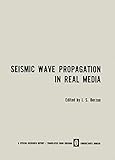Seismic wave propagation in real media Libro electrónico Edited by I. S. Berzon
Tipo de material: Libro
en línea Idioma: Inglés Detalles de publicación: New York, New York, United States Consultants Bureau c1969Descripción: vi, 208 páginas ilustraciones 28 centímetrosISBN:
Libro
en línea Idioma: Inglés Detalles de publicación: New York, New York, United States Consultants Bureau c1969Descripción: vi, 208 páginas ilustraciones 28 centímetrosISBN: - 9781475704853 (Print)
- 9781475704839 (Online)
- Disponible en línea
Incluye bibliografía: páginas 207-208
Chapter 1. Introduction.. 1. Introduction.. Chapter 2. Results of ultrasonic well logging.. 2. Equipment for full wave form ultrasonic logging.. 3. Universal equipment for borehole ultrasonic surveys.. 4. Acoustic insulation for ultrasonic logging.. 5. Statistical analysis of ultrasonic logging data.. 6. Velocity structure in the northern parts of the Krasnodar belt on the basis of ultrasonic logging data.. Chapter 3. Methods for and the principal results from theoretical studies of wave propagation.. 7. Analysis of the spectral characteristics of a thin-bedded sequence.. 8. Spectral analysis for recognition of wave forms.. 9. Interpretation of multidimensional spectrums for seismic waves.. 10. Physical basis for the use of reflected wave forms for studying groups of thin beds.. 11. The effect of the density ratio at a boundary on the form of the spectral response of a thin layer.. Chapter 4. Methods for and results from the study of wave propagation in real media.. 12. Methods for averaging the forms of recorded waves.. 13. The wave form of a longitudinal reflected wave from a thin high-speed layer.. 14. Head waves from thin layers (from field data.. 15. Shear waves reflected from a thin high-speed layer.. 16. Method for recording direct longitudinal waves at the surface and within a medium.. 17. The possibility of determining the filtering properties of the upper part of the section.. 18. Combined studies of the velocity characteristics in the upper part of the section.. 19. Secondary pulses on records of direct waves from shots in wells.. Bibliography
Disponible para usuarios de ECOSUR con su clave de acceso
Until recently, the interpretation of data obtained in seismic exploration has been based on comparatively simple representations of the Earth. The most commonly used representation for the Earthhas been a set of thick layers, each characterized by a single value for the propa gation speed of seismic waves. During the last several years, more complicated representa tions in the form of thin layers with vertical velocity gradients, as weIl as homogeneous thin layers have been considered. New methods for studying propagation speeds in a medium, particularly ultrasonic logging methods, and the results of theoretical and experimental studies of the dynamic characteristics of seismic waves have revealed that areal Earth is considerably more complicated than the simple models accepted in the past. This has led to a need for more realistic representations of the real Earth as a medium through wh ich seismic waves propagate. Because of this, tlie Department of Seismic Exploration Methods of the Institute of Physics of the Earth of the Acad emy of Sciences of the USSR has been carrying out both experimental and theoretical studies on the topic "Selection of Physical Representations of Actual Media and the Study of the Correspond ing Wave Propagation Effects. " Three major subdivisions have been recognized within this over all pro gram: 1. The establishment of a direct relationship between the structure of a real medium and the basic wave-propagation characteristics. Inglés
Disponible en línea
Disponible en formato PDF


